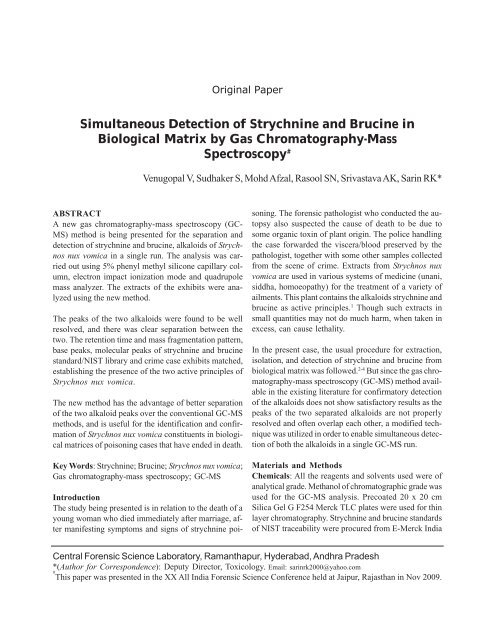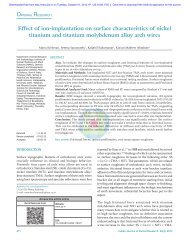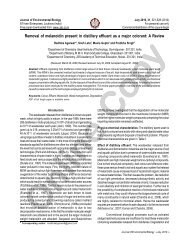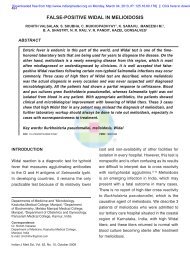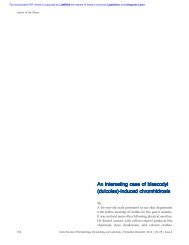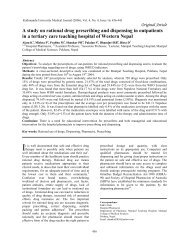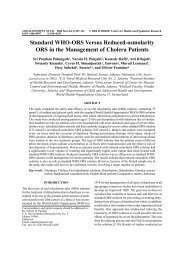Simultaneous Detection of Strychnine and Brucine in Biological ...
Simultaneous Detection of Strychnine and Brucine in Biological ...
Simultaneous Detection of Strychnine and Brucine in Biological ...
Create successful ePaper yourself
Turn your PDF publications into a flip-book with our unique Google optimized e-Paper software.
Orig<strong>in</strong>al Paper<br />
<strong>Simultaneous</strong> <strong>Detection</strong> <strong>of</strong> <strong>Strychn<strong>in</strong>e</strong> <strong>and</strong> <strong>Bruc<strong>in</strong>e</strong> <strong>in</strong><br />
<strong>Biological</strong> Matrix by Gas Chromatography-Mass<br />
Spectroscopy #<br />
Venugopal V, Sudhaker S, Mohd Afzal, Rasool SN, Srivastava AK, Sar<strong>in</strong> RK*<br />
ABSTRACT<br />
A new gas chromatography-mass spectroscopy (GC-<br />
MS) method is be<strong>in</strong>g presented for the separation <strong>and</strong><br />
detection <strong>of</strong> strychn<strong>in</strong>e <strong>and</strong> bruc<strong>in</strong>e, alkaloids <strong>of</strong> Strychnos<br />
nux vomica <strong>in</strong> a s<strong>in</strong>gle run. The analysis was carried<br />
out us<strong>in</strong>g 5% phenyl methyl silicone capillary column,<br />
electron impact ionization mode <strong>and</strong> quadrupole<br />
mass analyzer. The extracts <strong>of</strong> the exhibits were analyzed<br />
us<strong>in</strong>g the new method.<br />
The peaks <strong>of</strong> the two alkaloids were found to be well<br />
resolved, <strong>and</strong> there was clear separation between the<br />
two. The retention time <strong>and</strong> mass fragmentation pattern,<br />
base peaks, molecular peaks <strong>of</strong> strychn<strong>in</strong>e <strong>and</strong> bruc<strong>in</strong>e<br />
st<strong>and</strong>ard/NIST library <strong>and</strong> crime case exhibits matched,<br />
establish<strong>in</strong>g the presence <strong>of</strong> the two active pr<strong>in</strong>ciples <strong>of</strong><br />
Strychnos nux vomica.<br />
The new method has the advantage <strong>of</strong> better separation<br />
<strong>of</strong> the two alkaloid peaks over the conventional GC-MS<br />
methods, <strong>and</strong> is useful for the identification <strong>and</strong> confirmation<br />
<strong>of</strong> Strychnos nux vomica constituents <strong>in</strong> biological<br />
matrices <strong>of</strong> poison<strong>in</strong>g cases that have ended <strong>in</strong> death.<br />
Key Words: <strong>Strychn<strong>in</strong>e</strong>; <strong>Bruc<strong>in</strong>e</strong>; Strychnos nux vomica;<br />
Gas chromatography-mass spectroscopy; GC-MS<br />
Introduction<br />
The study be<strong>in</strong>g presented is <strong>in</strong> relation to the death <strong>of</strong> a<br />
young woman who died immediately after marriage, after<br />
manifest<strong>in</strong>g symptoms <strong>and</strong> signs <strong>of</strong> strychn<strong>in</strong>e poi-<br />
Central Forensic Science Laboratory, Ramanthapur, Hyderabad, Andhra Pradesh<br />
*(Author for Correspondence): Deputy Director, Toxicology. Email: sar<strong>in</strong>rk2000@yahoo.com<br />
#<br />
This paper was presented <strong>in</strong> the XX All India Forensic Science Conference held at Jaipur, Rajasthan <strong>in</strong> Nov 2009.<br />
19<br />
son<strong>in</strong>g. The forensic pathologist who conducted the autopsy<br />
also suspected the cause <strong>of</strong> death to be due to<br />
some organic tox<strong>in</strong> <strong>of</strong> plant orig<strong>in</strong>. The police h<strong>and</strong>l<strong>in</strong>g<br />
the case forwarded the viscera/blood preserved by the<br />
pathologist, together with some other samples collected<br />
from the scene <strong>of</strong> crime. Extracts from Strychnos nux<br />
vomica are used <strong>in</strong> various systems <strong>of</strong> medic<strong>in</strong>e (unani,<br />
siddha, homoeopathy) for the treatment <strong>of</strong> a variety <strong>of</strong><br />
ailments. This plant conta<strong>in</strong>s the alkaloids strychn<strong>in</strong>e <strong>and</strong><br />
bruc<strong>in</strong>e as active pr<strong>in</strong>ciples. 1 Though such extracts <strong>in</strong><br />
small quantities may not do much harm, when taken <strong>in</strong><br />
excess, can cause lethality.<br />
In the present case, the usual procedure for extraction,<br />
isolation, <strong>and</strong> detection <strong>of</strong> strychn<strong>in</strong>e <strong>and</strong> bruc<strong>in</strong>e from<br />
biological matrix was followed. 2-4 But s<strong>in</strong>ce the gas chromatography-mass<br />
spectroscopy (GC-MS) method available<br />
<strong>in</strong> the exist<strong>in</strong>g literature for confirmatory detection<br />
<strong>of</strong> the alkaloids does not show satisfactory results as the<br />
peaks <strong>of</strong> the two separated alkaloids are not properly<br />
resolved <strong>and</strong> <strong>of</strong>ten overlap each other, a modified technique<br />
was utilized <strong>in</strong> order to enable simultaneous detection<br />
<strong>of</strong> both the alkaloids <strong>in</strong> a s<strong>in</strong>gle GC-MS run.<br />
Materials <strong>and</strong> Methods<br />
Chemicals: All the reagents <strong>and</strong> solvents used were <strong>of</strong><br />
analytical grade. Methanol <strong>of</strong> chromatographic grade was<br />
used for the GC-MS analysis. Precoated 20 x 20 cm<br />
Silica Gel G F254 Merck TLC plates were used for th<strong>in</strong><br />
layer chromatography. <strong>Strychn<strong>in</strong>e</strong> <strong>and</strong> bruc<strong>in</strong>e st<strong>and</strong>ards<br />
<strong>of</strong> NIST traceability were procured from E-Merck India
20 JOURNAL OF THE INDIAN SOCIETY OF TOXICOLOGY (JIST) VOL 006 ISSUE 001 JAN-JUN 2 010<br />
Ltd. Visceral exhibits <strong>of</strong> stomach, <strong>in</strong>test<strong>in</strong>e, liver, spleen,<br />
kidney, blood, <strong>and</strong> sp<strong>in</strong>al cord sent by the forensic pathologist<br />
constituted the biological matrices, while other<br />
crime scene exhibits <strong>in</strong>cluded a steel vessel, a sieve for<br />
filter<strong>in</strong>g, <strong>and</strong> a polythene milk packet.<br />
Apparatus: The follow<strong>in</strong>g equipment was used for the<br />
study -<br />
St<strong>and</strong>ard TLC apparatus from E-Merck<br />
Gas chromatograph-Mass spectrometer, Perk<strong>in</strong> Elmer<br />
GC Model: Perk<strong>in</strong> Elmer<br />
MS Model: PE-Turbo Matrix.<br />
S<strong>of</strong>tware: Turbo Mass.<br />
Preparation <strong>of</strong> St<strong>and</strong>ard Solution: St<strong>and</strong>ard solution<br />
<strong>of</strong> strychn<strong>in</strong>e <strong>and</strong> bruc<strong>in</strong>e was prepared by dissolv<strong>in</strong>g<br />
10mg each <strong>in</strong> 10 ml pure methanol to obta<strong>in</strong> a concentration<br />
<strong>of</strong> 1mg/ml.<br />
Extraction from <strong>Biological</strong> Matrices: The method<br />
used for the extraction was basically from the work<strong>in</strong>g<br />
manual <strong>of</strong> the Directorate <strong>of</strong> Forensic Science (DFS),<br />
New Delhi, with m<strong>in</strong>or modifications to suit the nature<br />
<strong>and</strong> quantity <strong>of</strong> the exhibit. 5<br />
50 gm <strong>of</strong> macerated tissue <strong>of</strong> stomach <strong>and</strong> <strong>in</strong>test<strong>in</strong>e was<br />
mixed with 50 ml <strong>of</strong> rectified spirit <strong>in</strong> a conical flask <strong>and</strong><br />
acidified with tartaric acid. The conical flask was heated<br />
on the water bath for about 1 hour. The resultant mixture<br />
was then filtered through a filter paper. The filtrate<br />
was evaporated <strong>and</strong> the residue added to 50 ml <strong>of</strong> warm<br />
distilled water <strong>and</strong> filtered through a Whatman filter paper.<br />
The filtrate was transferred to a separat<strong>in</strong>g funnel<br />
<strong>and</strong> rendered alkal<strong>in</strong>e with ammonia solution, <strong>and</strong> extracted<br />
with a diethyl ether solvent, <strong>in</strong> portions <strong>of</strong> about<br />
25 ml at each extraction for three times. The extract<br />
was purified by dissolv<strong>in</strong>g it <strong>in</strong> about 20 ml <strong>of</strong> water acidulated<br />
with dilute sulphuric acid <strong>and</strong> filter<strong>in</strong>g through a<br />
Whatman filter paper. The filtrate was extracted with<br />
diethyl ether solvent <strong>in</strong> portions <strong>of</strong> 25ml at each extraction<br />
for three times. These extracts were evaporated to<br />
dryness for analysis.<br />
From the above extract, after the extraction procedure,<br />
the follow<strong>in</strong>g colour test was performed as per the DFS<br />
work<strong>in</strong>g procedure manual. The results are mentioned <strong>in</strong><br />
Table 1.<br />
TLC Conditions:<br />
Solvent System: Cyclohexane: Toluene: Diethyl am<strong>in</strong>e<br />
(75:15:10)<br />
Plate: Silica gel G (0.2 mm thickness)<br />
Development: Ascend<strong>in</strong>g technique.<br />
Spray reagent: Dragendorff's Reagent<br />
Colour <strong>of</strong> spot: Orange<br />
Gas Chromatographic Conditions:<br />
Column: Capillary column packed with 5% methyl phenyl<br />
silicone.<br />
Length: 30 mts, <strong>in</strong>ternal diameter 0.25mm.<br />
Carrier gas: Helium.<br />
Flow rate: 1ml/mt.<br />
Temperature programm<strong>in</strong>g -<br />
Oven temperature: 150C for 1 m<strong>in</strong>, Ramp1-9C degree/<br />
m<strong>in</strong> to 280C hold for 8 m<strong>in</strong>.<br />
Injector temperature: 150C.<br />
Temperature <strong>of</strong> <strong>in</strong>terface: 300C<br />
Injection volume: 1microlitre.<br />
Mass Spectroscopy Conditions:<br />
Reagent Gas for Tun<strong>in</strong>g <strong>and</strong> Calibration: Heptacosa<br />
tributyl am<strong>in</strong>e.<br />
Mode: Full scan mode.<br />
Ionization: Electron Impact ionization.<br />
Source Temperature: 250C.<br />
Interface Temperature: 250C.<br />
Results <strong>and</strong> Discussion<br />
For the detection <strong>of</strong> the two nux vomica alkaloids (strychn<strong>in</strong>e<br />
<strong>and</strong> bruc<strong>in</strong>e), TLC <strong>and</strong> colour test were performed<br />
as per st<strong>and</strong>ard procedure. The observations are given<br />
<strong>in</strong> Table 1. The observations <strong>of</strong> Rf values perta<strong>in</strong><strong>in</strong>g to<br />
TLC, <strong>and</strong> the results <strong>of</strong> the colour test <strong>in</strong>dicate the positive<br />
presence <strong>of</strong> the alkaloids <strong>in</strong> all the exhibits.<br />
Fig 1 shows the total ion chromatogram <strong>of</strong> the strychn<strong>in</strong>e<br />
<strong>and</strong> bruc<strong>in</strong>e st<strong>and</strong>ards, while Fig 2 shows the total<br />
ion chromatogram <strong>of</strong> the exhibit. TLC shows well resolved<br />
chromatographic peaks, both <strong>in</strong> the st<strong>and</strong>ards as<br />
well as exhibits, which are not generally achieved with<br />
the conventional method. Experimental condition retention<br />
time <strong>of</strong> strychn<strong>in</strong>e st<strong>and</strong>ards were found to be 12.08,<br />
15.04 respectively. However, the retention time <strong>of</strong> the<br />
two correspond<strong>in</strong>g peaks <strong>in</strong> the exhibits were found to<br />
be match<strong>in</strong>g (Table 2).
ORIGINAL PAPER: DETECTION OF STRYCHNINE AND BRUCINE IN BIOLOGICAL MATRIX BY GC-MS<br />
Fig 3 shows the mass spectra <strong>of</strong> st<strong>and</strong>ard strychn<strong>in</strong>e<br />
<strong>and</strong> bruc<strong>in</strong>e peaks, while Fig 4 shows the mass spectra<br />
<strong>of</strong> the exhibits. Table 2 shows the base peaks, molecular<br />
peaks, <strong>and</strong> major fragments <strong>of</strong> both the st<strong>and</strong>ards<br />
<strong>and</strong> exhibits. All the parameters with reference to st<strong>and</strong>ards<br />
<strong>and</strong> exhibits for both the peaks were found to be<br />
match<strong>in</strong>g, which is sufficient confirmation <strong>of</strong> the presence<br />
<strong>of</strong> strychn<strong>in</strong>e <strong>and</strong> bruc<strong>in</strong>e <strong>in</strong> all the exhibits.<br />
Conclusion<br />
A reproducible <strong>and</strong> sensitive s<strong>in</strong>gle-run GC-MS method<br />
for simultaneous determ<strong>in</strong>ation <strong>and</strong> confirmation <strong>of</strong><br />
strychn<strong>in</strong>e <strong>and</strong> bruc<strong>in</strong>e <strong>in</strong> exhibits <strong>of</strong> forensic <strong>in</strong>terest has<br />
21<br />
been developed. The method developed is useful <strong>in</strong> the<br />
toxicological analysis <strong>of</strong> biological matrices for the detection<br />
<strong>of</strong> strychn<strong>in</strong>e <strong>and</strong> bruc<strong>in</strong>e which are active pr<strong>in</strong>ciples<br />
<strong>of</strong> Strychnos nux vomica, <strong>and</strong> has some advantages<br />
over the conventional method.<br />
Acknowledgement<br />
The authors would like to thank Dr. SK Shukla, Director,<br />
Central Forensic Science Laboratory, Ch<strong>and</strong>igarh, for his<br />
valuable suggestions, <strong>and</strong> Shri AK Ganjoo, Director, Central<br />
Forensic Science Laboratory, Hyderabad, for his keen<br />
<strong>in</strong>terest <strong>and</strong> encouragement.<br />
Table 1 Retention Time <strong>and</strong> Colour Test Results <strong>of</strong> St<strong>and</strong>ard <strong>Strychn<strong>in</strong>e</strong> & <strong>Bruc<strong>in</strong>e</strong> & Exhibits<br />
Serial No. Name <strong>of</strong> the Exhibit Colour Test 1 Colour Test 2 Retention Time<br />
1. Exhibit 1 (stomach <strong>and</strong> <strong>in</strong>test<strong>in</strong>e) +ve +ve 0.484,0.40.<br />
2. Exhibit 2 (liver, kidney <strong>and</strong> spleen) +ve +ve 0.484,0.40.<br />
3. Exhibit 3 (sp<strong>in</strong>al cord) +ve +ve 0.484,0.40.<br />
4. Exhibit 4 (blood) +ve +ve 0.484,0.40.<br />
5. Exhibit 5 (leaves <strong>and</strong> stalk <strong>of</strong> plant) +ve +ve 0.484,0.40.<br />
6. Exhibit 6 (steel bowl) +ve +ve 0.484,0.40.<br />
7. Exhibit 7 (metal sieve) +ve +ve 0.484,0.40.<br />
<strong>Strychn<strong>in</strong>e</strong> +ve +ve 0.484<br />
<strong>Bruc<strong>in</strong>e</strong> +ve +ve 0.40.<br />
Table 2 Retention Indices (Gas Chromatography) <strong>of</strong> <strong>Strychn<strong>in</strong>e</strong> & <strong>Bruc<strong>in</strong>e</strong> & Exhibits<br />
Serial No. Name <strong>of</strong> the Exhibit Retention Indices<br />
1. Exhibit 1 (stomach <strong>and</strong> <strong>in</strong>test<strong>in</strong>e) 12.29,14.97<br />
2. Exhibit 2 (liver, kidney <strong>and</strong> spleen) 12.29,14.97<br />
3. Exhibit 3 (sp<strong>in</strong>al cord) 12.29,14.97<br />
4. Exhibit 4 (blood) 12.29,14.97<br />
5. Exhibit 5 (leaves <strong>and</strong> stalk <strong>of</strong> plant) 12.29,14.97<br />
6. Exhibit 6 (steel bowl) 12.29,14.97<br />
7. Exhibit 7 (metal sieve) 12.29,14.97<br />
<strong>Strychn<strong>in</strong>e</strong> 12.09<br />
<strong>Bruc<strong>in</strong>e</strong> 15.41
22 JOURNAL OF THE INDIAN SOCIETY OF TOXICOLOGY (JIST) VOL 006 ISSUE 001 JAN-JUN 2 010<br />
Table 3 Molecular Weight, Base Peak, Major Fragments <strong>of</strong> <strong>Strychn<strong>in</strong>e</strong>, <strong>Bruc<strong>in</strong>e</strong> <strong>and</strong> Exhibits<br />
Sample Retention time Molecular weight Base peak/ Major fragments<br />
or M/Z Molecular peak<br />
<strong>Strychn<strong>in</strong>e</strong> 12.09 334 334 130,120,107<br />
<strong>Bruc<strong>in</strong>e</strong> 15.41 394 379 379,203,197<br />
Exhibit 1 12.29,15.04 334 & 394 334,394 130,120,203,197<br />
Exhibit 2 12.29,15.04 334 & 394 334,394 130,120,203,197<br />
Exhibit 3 12.29,15.04 334 & 394 334,394 130,120,203,197<br />
Exhibit 4 12.29,15.04 334 & 394 334,394 130,120,203,197<br />
Exhibit 5 12.29,15.04 334 & 394 334,394 130,120,203,197<br />
Exhibit 6 12.29,15.04 334 & 394 334,394 130,120,203,197<br />
Exhibit 7 12.29,15.04 334 & 394 334,394 130,120,203,197<br />
std <strong>Strychn<strong>in</strong>e</strong> <strong>and</strong> <strong>Bruc<strong>in</strong>e</strong> Scan El +<br />
15.41<br />
100<br />
TIC<br />
4.93e6<br />
%<br />
0<br />
12.09<br />
Fig. 1<br />
15.10<br />
4.00 6.00 8.00 10.00 12.00 14.00 16.00 18.00<br />
Time
ORIGINAL PAPER: DETECTION OF STRYCHNINE AND BRUCINE IN BIOLOGICAL MATRIX BY GC-MS<br />
std <strong>Strychn<strong>in</strong>e</strong><br />
Case Exhibit<br />
std <strong>Strychn<strong>in</strong>e</strong> <strong>and</strong> <strong>Bruc<strong>in</strong>e</strong> 498 (12.132)<br />
std <strong>Strychn<strong>in</strong>e</strong> <strong>and</strong> <strong>Bruc<strong>in</strong>e</strong> 670 (15.286)<br />
Hit Rev Library For Compound Name<br />
1 688 Nist 420 STRYCHNINE<br />
std <strong>Strychn<strong>in</strong>e</strong> <strong>and</strong> <strong>Bruc<strong>in</strong>e</strong> 498 (12.132)<br />
<strong>Strychn<strong>in</strong>e</strong><br />
Fig. 2<br />
Fig. 3<br />
Fig. 4<br />
<strong>Bruc<strong>in</strong>e</strong><br />
MW Formula CAS<br />
334 C 21 H 22 O 2 N 2 57-24-9<br />
Scan El +<br />
TIC<br />
2.13e7<br />
1.82e5<br />
Scan El +<br />
1.82e5<br />
Scan El +<br />
5.24e5<br />
23
24 JOURNAL OF THE INDIAN SOCIETY OF TOXICOLOGY (JIST) VOL 006 ISSUE 001 JAN-JUN 2 010<br />
Hit REV For Compound Name MW Formula<br />
1 761 314 BENZENEHEXACARBOXYLIC ACID, HEXAMETHLY ESTER 426 C 18 H 18 O 12<br />
2 404 312 BRUCINE 394 C 23 H 26 O 4 N 2<br />
std <strong>Strychn<strong>in</strong>e</strong> <strong>and</strong> <strong>Bruc<strong>in</strong>e</strong> 677 (15.413) Cm (652:705-(727+633))<br />
REFERENCES<br />
1. Parikh CK. Parikh's Textbook <strong>of</strong> Medical Jurisprudence,<br />
Forensic Medic<strong>in</strong>e <strong>and</strong> Toxicology. 6th edn, 2007. New<br />
Delhi: CBS Publishers & Distributors.<br />
2. Chopra RN, Nayar SL, Chopra IC. Glossary <strong>of</strong> Indian Medic<strong>in</strong>al<br />
Plants. 1956. New Delhi: Council <strong>of</strong> Scientific &<br />
Industrial Research. p329.<br />
3. Khare CP. Indian Medic<strong>in</strong>al Plants: An Illustrated Dictionary.<br />
2008. Spr<strong>in</strong>ger-Verlag Heidelberg.<br />
Fig. 5<br />
2.60e5<br />
4. Goutam MP, Goutam S. Analysis <strong>of</strong> Plant Poisons. 2009.<br />
New Delhi: Selective <strong>and</strong> Scientific Books.<br />
5. Central Forensic Science Laboratory, Hyderabad. Work<strong>in</strong>g<br />
Procedure Manual - Toxicology. Directorate <strong>of</strong> Forensic<br />
Science, New Delhi.


